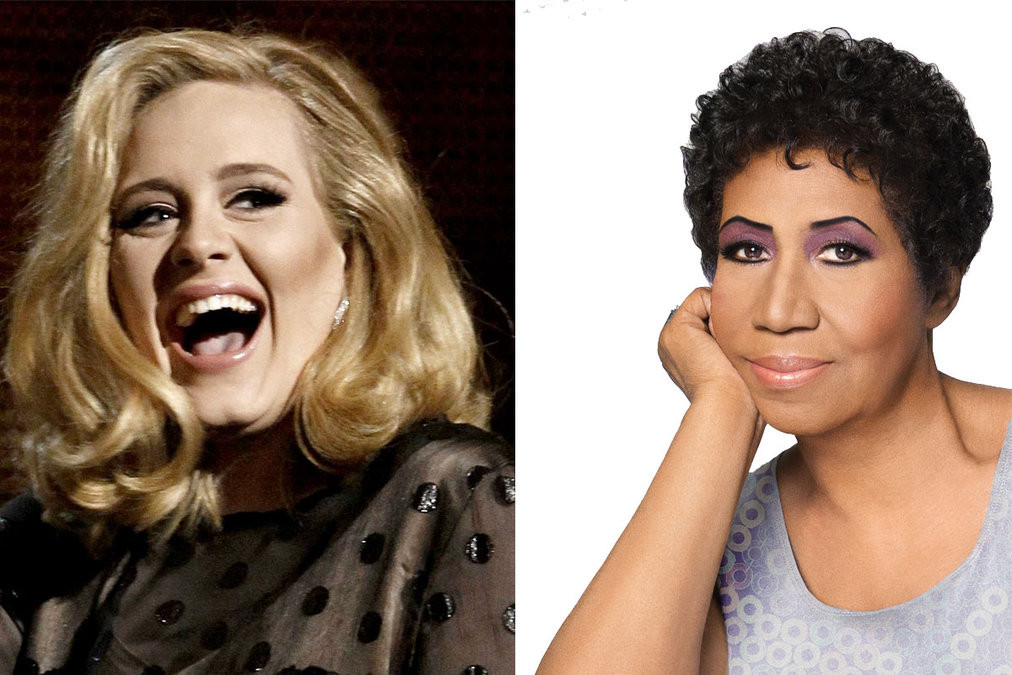The Queen of Soul, Aretha Franklin, made waves with her rendition of a contemporary hit, Adele’s powerhouse anthem, “Rolling in the Deep.” Featured on her album, “Aretha Franklin Sings the Great Diva Classics,” this cover sparked considerable debate and divided opinions. While some questioned its inclusion among timeless classics and legends like Etta James and Gladys Knight, the track undeniably served as a bold statement. The release of Aretha’s version immediately ignited comparisons to Adele’s original, prompting the crucial question: who truly reigns supreme in this soulful rendition of “Rolling in the Deep”?
 Aretha Franklin and Adele side-by-side performance comparison
Aretha Franklin and Adele side-by-side performance comparison
While acknowledging Adele’s songwriting prowess and original connection to “Rolling in the Deep,” it’s impossible to ignore Aretha Franklin’s unparalleled ability to transform any song into a vessel of profound musicality. However, the recency and immense popularity of Adele’s version inevitably cast a long shadow. Many online commentators swiftly declared “Adele wins,” or echoed sentiments like “It’s Adele’s song,” sometimes dismissing Aretha’s take as “screaming” or overly processed with “auto-tune.” But to truly appreciate each artist’s interpretation, we need to dissect the nuances. Let’s delve into a detailed comparison of these two distinct versions of “Rolling in the Deep,” examining the vocal performances, emotional resonance, and musicianship that each singer brings to the table. Is it a case of the original’s raw emotion versus the legend’s seasoned artistry? Let’s explore.
1) The Auto-Tune Factor: Production Choices in Both Versions
A noticeable element in Aretha Franklin’s cover of “Rolling in the Deep” is the presence of auto-tune. Its inclusion is somewhat perplexing, especially given Aretha’s legendary vocal capabilities. The intention might have been to give the track a modern, polished sound, aligning it with contemporary radio aesthetics. However, for many listeners, the auto-tune feels unnecessary and even detracts from the raw, organic power expected from the Queen of Soul. It raises questions about whether it was used for subtle pitch correction, which would be surprising given Aretha’s established vocal precision. Regardless of the reason, the auto-tune is undeniably noticeable in certain parts of her rendition and is a point of contention for critics and fans alike. In contrast, Adele’s original “Rolling in the Deep” is celebrated for its raw, unfiltered vocal performance. The production emphasizes the emotional grit and power of her voice without any apparent digital manipulation. This difference in production style significantly impacts the listening experience and the perceived authenticity of each version. While Adele’s version thrives on its natural, emotive delivery, Aretha’s cover grapples with a production choice that arguably obscures her inherent vocal strengths.
2) Emotional Connection: Original Songwriter vs. Soulful Interpreter
Emotion is the lifeblood of “Rolling in the Deep,” a song brimming with heartbreak and resilience. As the songwriter, Adele’s connection to the song is deeply personal, stemming from her own experiences and narrative. Her performance channels this raw emotionality directly, making the original version resonate profoundly with listeners who connect with the song’s themes of lost love and defiance. However, to assume Aretha Franklin lacks emotional investment would be a disservice to her artistry. As a gospel-trained vocalist and the Queen of Soul, Aretha possesses an innate ability to inhabit a song, regardless of its origin. Her background in gospel music instilled in her a profound understanding of conveying emotion and meaning through song. While she may not have penned “Rolling in the Deep,” Aretha’s interpretation is infused with her signature soulful delivery. She approaches the song as a seasoned interpreter, drawing upon her vast emotional and musical vocabulary to connect with the lyrics and communicate their essence in her own unique way. The emotional connection differs; Adele’s is born from creation, while Aretha’s is forged through masterful interpretation.
3) Musicianship and Interpretive Artistry: Distinct Approaches to a Hit Song
Both Adele and Aretha Franklin are accomplished musicians and songwriters, but their approaches to “Rolling in the Deep,” and music in general, highlight their distinct artistic strengths. Adele, known for her introspective songwriting, delivers a version that is intrinsically linked to her personal style and emotional landscape. Her musicianship is evident in the song’s composition and her authentic performance. Aretha Franklin, on the other hand, is renowned for her transformative interpretations of other artists’ songs. Her career is studded with covers that not only rivaled but often surpassed the originals in popularity and impact, such as “Respect” and “Bridge Over Troubled Water.” This ability to reimagine and elevate existing songs is a cornerstone of her legendary status. While Adele’s covers, like her renditions of Etta James and Bob Dylan songs, are commendable, they largely remain faithful to the original spirit. Aretha’s “Rolling in the Deep” is a bolder reimagining, showcasing her capacity to take a contemporary hit and mold it into a soulful expression that bears her unmistakable stamp. This contrast underscores their differing musical approaches: Adele excels in original, deeply personal songwriting and performance, while Aretha shines as a masterful interpreter who can infuse any song with her unparalleled soul and musicality.
4) Vocal Prowess: Comparing Two Iconic Voices
Comparing Adele and Aretha Franklin’s vocals is akin to comparing two different schools of vocal artistry. Aretha Franklin is a dramatic mezzo-soprano, blessed with a naturally voluminous, powerful voice that spans a remarkable range, from resonant low notes to soaring highs. Her vocal style is characterized by dramatic flair, intricate melisma, and a commanding presence. Adele, a lyric mezzo-soprano, possesses a voice that is comparatively smaller in volume, with a more melancholic, emotive timbre. Her strength lies in her distinctive husky tone, her nuanced phrasing, and her ability to convey raw emotion with remarkable intimacy. Technically, Aretha is widely regarded as the superior vocalist. Her mastery of vocal technique, encompassing breath control, larynx position, vocal placement, and agility in runs and riffs, is virtually unmatched. Even in her seventies, despite the natural effects of aging and decades of performance, her vocal skill remains impressive. While Adele’s vocal ability is undeniable, it’s grounded more in emotive delivery and tonal quality than in technical virtuosity. Her appeal lies in the relatability and emotional depth of her voice, whereas Aretha’s impact stems from her sheer vocal power, range, and technical brilliance. To declare one “better” is subjective and overlooks the unique strengths each vocalist brings to “Rolling in the Deep.” They represent different peaks of vocal excellence, each captivating in their own right.
5) Live Performance: Studio vs. Stage Dynamics
The studio versions of “Rolling in the Deep” offer distinct listening experiences, but examining live performances adds another layer to the comparison. Aretha Franklin’s live performance of the song on Letterman offered a crucial counterpoint to the studio track. Freed from studio enhancements like auto-tune, her live rendition showcased her raw vocal power and improvisational artistry. While age inevitably impacts vocal stamina and agility, Aretha’s live performance demonstrated that her core vocal strengths – power, resonance, and soulful delivery – remained potent. The performance wasn’t without its wobbles, particularly in the opening phrases, but as the song progressed, Aretha’s voice gained strength, culminating in a classic, church-infused performance, complete with a creative interpolation of “Ain’t No Mountain High Enough.” This live rendition served as a reminder of Aretha’s enduring stage presence and her ability to connect with an audience in real-time. Adele is also known for her captivating live performances, characterized by her emotive delivery and connection with her audience. While comparisons of live performances are inherently complex due to variables like age and vocal condition, Aretha’s live “Rolling in the Deep” underscored her enduring vocal prowess and her capacity to command a stage, even when revisiting a contemporary hit.
In Conclusion:
Ultimately, choosing a “better” version of “Rolling in the Deep” between Adele and Aretha Franklin is a matter of personal preference and artistic appreciation. Adele’s original is a raw, emotionally charged anthem, deeply connected to her personal narrative and delivered with authentic intensity. Aretha Franklin’s cover is a testament to her enduring musicianship and interpretive genius, transforming a modern hit into a soulful showcase of her legendary vocal prowess. While production choices in Aretha’s version may be debated, and age inevitably shapes vocal performance, her rendition stands as a compelling example of her ability to reimagine and revitalize any song. Both versions offer unique strengths and insights into the artistry of two iconic vocalists. The question isn’t who is “better,” but rather, which version resonates most deeply with you and best exemplifies the power of “Rolling in the Deep.” What are your thoughts? Which rendition captures your soul?


